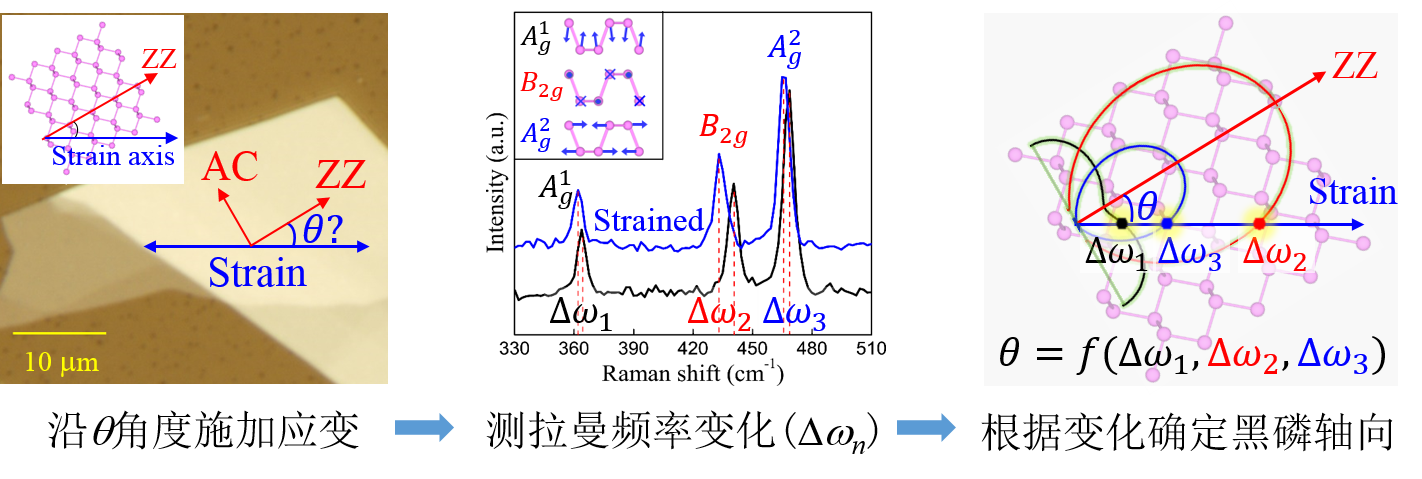Identification of crystalline orientation
时间:2020-12-30
In-plane uniaxial strain in black phosphorus enables the identification of crystalline orientation
Black phosphorus is another two-dimensional atomic crystal in the form of simple substance after graphene. Compared with bulk materials, two-dimensional crystals have greater flexibility and compression resistance, and can withstand greater stress and deformation. Strain engineering based on two-dimensional materials is an effective method to modulate its optical and electrical properties. Different from graphene and hexagonal boron nitride, molybdenum disulfide and other two-dimensional materials, black phosphorus is anisotropic. Its mechanical properties, photoelectric response, mobility, absorption spectrum, optical contrast, fluorescence spectrum and Raman spectrum all show significant anisotropy. Therefore, the determination of the lattice orientation of black phosphorus is very important for the study and application of its physical and chemical properties. Raman spectroscopy, as a fast and nondestructive analysis method, plays a key role in the characterization of two-dimensional crystal structure and properties. Then, do the Raman peaks of two-dimensional black phosphorus follow some specific rules under the action of strain? Can these rules provide guidance for the characterization, design and application of black phosphorus samples?
To answer these problems, Prof. Liu Zhirong, Prof. Zhang Jin, Prof. Tong Lianming, Dr. Zhang Shuqing and other researchers from the college of chemistry and molecular engineering of Peking University have developed a model to judge the lattice orientation of black phosphorus by using the strain-induced Raman frequency change, and calculated the strain transfer efficiency between the black phosphorus sample and the flexible substrate in experiment. The results show that the three typical Raman modes (Ag1, B2g, Ag2) of black phosphorus follow different changing rules under strain. The changing rate of each mode in any direction of strain can be obtained by the combination of the zigzag and armchair frequency changing rates. According to the changing combination of the three characteristic mode frequencies, the angle between the strain and the crystal axis of black phosphorus can be uniquely determined. Based on these results, they developed an effective method to determine the orientation of black phosphorus lattice by using the Raman response signal under strain, and can further determine the strain transfer efficiency in actual experiments.

Compared with the method of angle resolved polarization Raman spectroscopy based on the change of Raman intensity, the change of Raman frequency mainly depends on the symmetry of the whole lattice structure and the change of bond length and bond angle, and is less affected by the optical interference and diffraction effect caused by external environmental factors (laser wavelength, substrate type, even sample birefringence, etc.). In addition, the three representative Raman modes of black phosphorus mainly come from the relative vibration between atoms in the black phosphorus layer, which has little relationship with the interlayer coupling, so the frequencies of the three characteristic peaks hardly change with the number of layers. Therefore, it is robust to identify the lattice direction by Raman frequency change of black phosphorus, which is almost not affected by laser polarization, wavelength, sample thickness and optical effect of substrate.
The stress / strain experiment of two-dimensional materials is usually realized by stretching its flexible substrate. The actual stress / strain of the sample depends on the interaction between the substrate and the sample. The strain transfer efficiency of the experimental device is defined as the ratio of the actual strain to the applied amount, which corresponds to the actual rate of change (experimental value) and the ideal rate of change (calculated value) of Raman frequency under strain Calculated value). It is found that the strain transfer efficiency from the substrate to the sample is only 20% ~ 40% for the strain experiment in which black phosphorus is directly placed on the pet substrate. The change rate of three characteristic Raman frequencies of black phosphorus is normalized to offset the absolute error of single vibration mode frequency measurement in the experiment. The average error between the angle between the strain calculated by this method and the zigzag direction of black phosphorus is only 4.1 degree It further shows that the theoretical model can accurately judge the lattice orientation of black phosphorus through its frequency change under strain, and it is almost not affected by different experimental conditions.
This method can be extended to other two-dimensional atomic crystals.
The related work was published as:
Shuqing Zhang, Nannan Mao, Juanxia Wu, Lianming Tong*, Jin Zhang*, and Zhirong Liu*.
In-plane uniaxial strain in black phosphorus enables the identification of crystalline orientation.
Small 13 (30), 1700466/1-9 (2017).
Link: https://onlinelibrary.wiley.com/doi/full/10.1002/smll.201700466
Media reports:
Materials Views China:http://www.materialsviewschina.com/2017/07/25958/




